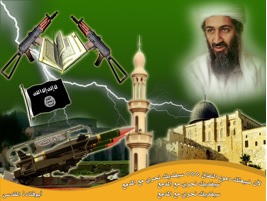
The caption at the bottom is from a famous nashid (religious a capella song) that reads: “dayya’atki dumu’ al-nifaq; sa-yafdiki nahri ma’a al-madma'” (“tears of hypocrisy have squandered you away; so my throat will redeem you with tears”).
The image contains several familiar elements from jihadi visual propaganda, including black banner, a holy site and other religious structures, crossed rifles, a Qur’an, lightning bolts, a dominant green background and the face of Usama bin Ladin. According to prophetic tradition (hadith), the black flag was the battle flag of the Prophet Muhammad and it was carried into battle by many of his companions. The image of the black flag has been used as a symbol of religious revolt and engagement in battle (i.e., jihad). In the contemporary Islamist movement, the black flag with the shahada (Islamic testimony of faith holding that there is no god but Allah and that Muhammad is his messenger) is used to evoke notions of jihad and of reestablishing the Islamic Caliphate.
Finally, the al-Aqsa mosque is recognized and revered by all Muslims, but it is mostly a powerful symbol of Palestinian nationhood. It is considered the third holiest site in Islam after Mecca and al-Madina. Its appearance in this context ties together the two theaters of jihad, Iraq and Israel/Palestine, as part of the global jihad movement. In addition, the appearance of Usama bin Ladin serves to remind the viewer of the Islamic State of Iraq’s organizational affiliation with al-Qa’ida and to lend the group an aura of legitimacy.
 Skip to content
Skip to content
